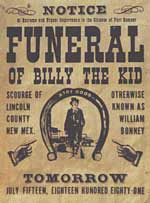|

 Appalachian
Spring Appalachian
Spring
All three of Copland's "Americana" ballets became instantly
popular - this is the one that achieved iconic stature. The big moment
is when the song "Simple Gifts" is introduced - first as a
clarinet solo, then in variations, finally with the melody stated by
the full ensemble.
 |
 |
 |
Billy the
Kid funeral poster |
 Billy
the Kid Billy
the Kid
This ballet isn't a historical picture of William Bonney, but a mythical
account of Billy the Kid, who witnesses his mother's death by gunfire,
becomes a gunslinger himself, and is shot down himself, against the
backdrop of the settling of the American West.
 Clarinet
Concerto Clarinet
Concerto
Written for jazzman Benny Goodman. You can imagine some of its flavor
if you know that choreographer Jerome Robbins used it in a (non-fairy-tale)
dance called The Pied Piper.
 El
Salon Mexico El
Salon Mexico
Traditional Mexican tunes, transformed and Copland-ized into a brilliant
orchestral rhapsody. The title means roughly "The Mexico City Dance
Hall," and was the name of a real establishment in Mexico that
Copland visited in 1932.
 Fanfare
for the Common Man Fanfare
for the Common Man
One of a series of patriotic fanfares commissioned during World War
II by the Cincinnati Symphony.
Copland turned out brief pieces for special occasions throughout his
career; as he wrote this one, he probably never imagined that it would
go on to become one of his best-known works.
 Lincoln
Portrait Lincoln
Portrait
After an extended orchestral introduction, the narrator of Lincoln Portrait
rises to intone the words of Abraham Lincoln, concluding with the peroration
of the Gettysburg Address.
Lincoln's prose has held up pretty well, but the connecting words of
the text ("This is what he said. This is what Abe Lincoln said.")
have led to numerous parodies over the years.
 Outdoor
Overture Outdoor
Overture
An exuberant piece, originally written for the music students at New
York's High School for Music and the Arts.
 Quiet
City Quiet
City
A slow, jazz-inflected nocturne, with searching solo lines
for trumpet and English horn.
 Rodeo Rodeo
Of all Copland's scores, the most immediately accessible
and infectious. It's best known in the form of Four Dance Episodes
from Rodeo - a slight abridgment of the complete ballet.
 Third
Symphony Third
Symphony
Copland's biggest score, apart from opera. Its composition coincided
with the end of World War II, and Copland said it was "intended
to reflect the euphoric spirit of the country at the time." The
last movement incorporates the Fanfare for the Common Man, stated
quietly at first, then in a big fortissimo statement at the very end.
10
Chapters | 10
Works | 10 Anecdotes | 10
Legacies | 10 People
10 Sources | 10
Quotes About Copland | 10 Facts
10
Quotes from Copland | 10 Audio Clips
| Copland 10x10 Home
|

